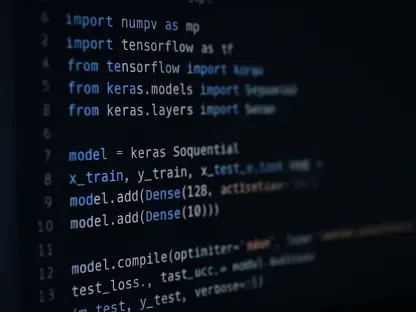In 2025, the software development landscape is witnessing a renewed focus on accelerating the delivery of applications while ensuring high-quality standards. Continuous integration and continuous deployment/delivery (CI/CD) tools have become critical components in the DevOps ecosystem, profoundly altering how development teams operate. These tools facilitate rapid deployments, enhance collaboration, and reduce manual errors. As software lifecycles grow more complex due to increased market demands, the role of CI/CD tools in maintaining agility and reliability in deployment pipelines has never been more vital.
Evolution of CI/CD Tools
Advancements in Automation and Integration
CI/CD tools are undergoing a significant transformation driven by advancements in intelligent automation and tighter integrations within software testing frameworks. This evolution emphasizes that CI/CD solutions must seamlessly integrate with testing protocols to sustain software quality and expedite delivery efforts. As businesses align their technology stacks with hybrid and cloud-native architectures, the need for sophisticated CI/CD solutions that can cater to diverse environments is expanding.
For instance, Jenkins remains a standout tool, appreciated for its adaptability and extensive plugin ecosystem, making it suitable for organizations needing detailed control over pipelines. Yet, this flexibility comes with the trade-off of requiring substantial setup and maintenance efforts. In contrast, GitHub Actions offers an alternative with its native integration within GitHub, streamlining workflow automation through its robust marketplace of pre-built actions, making it particularly efficient for open-source projects and large-scale enterprise applications. These developments ensure that CI/CD tools maintain relevance by evolving with industry demands.
Adapting to Cloud-Native and Hybrid Architectures
The movement towards cloud-native and hybrid environments is reshaping the expectations for CI/CD tools. DevOps teams demand solutions that support not just public cloud services but also on-premise infrastructures, creating a hybrid development ecosystem. GitLab CI/CD answers this call with its comprehensive DevOps platform, combining code management, testing, and deployment under one roof. Its auto DevOps features and user-friendly interface suit teams looking for an integrated environment.
CircleCI also excels in this regard with its focus on speed and scalable solutions. It offers both cloud-hosted and self-hosted options, meeting the demand for flexibility in deployment environments. This makes CircleCI a prime candidate for high-volume projects requiring complex workflows, benefiting from its advanced caching capabilities that accelerate build processes. Azure DevOps further extends this flexibility by delivering a full suite of tools tailored to Microsoft’s ecosystem, accommodating multi-platform and multi-language support essential for Microsoft-centric development teams.
Key CI/CD Tools That Stand Out
Navigating Diverse Functionalities and Adoption Contexts
Understanding the diverse functionalities and adoption contexts of prominent CI/CD tools provides organizations with critical insights needed to make informed decisions. Bitbucket Pipelines, Atlassian’s CI/CD solution, is purpose-designed for those utilizing Atlassian tools like Jira and Trello. By supporting YAML configuration and Docker, Bitbucket Pipelines delivers straightforward CI/CD processes that naturally integrate with teams using the wider Atlassian suite.
Another noteworthy contender is TeamCity, developed by JetBrains, appreciated for its advanced build configurations and customization capabilities. This makes it particularly beneficial for experienced DevOps teams managing complex pipelines and diverse testing scenarios. These tools reflect varied strengths—some focus on flexibility and customization, while others prioritize ease of use and ecosystem integration—allowing organizations to choose solutions that best meet their specific developmental needs.
Specialized Features Driving Technological Advancements
Specialized features in CI/CD tools continue to drive technological advancements in the industry. Jenkins’s open-source nature offers unmatched flexibility due to its large community support and vast array of plugins. Meanwhile, GitHub Actions enables streamlined workflow automation through its extensive marketplace, facilitating easy CI/CD setup without extensive programming knowledge.
Azure DevOps provides a unique edge with its integrated approach, allowing development teams to manage their entire pipeline within one platform. It embraces multi-language, multi-platform development, giving it an advantage for organizations heavily invested in Microsoft’s ecosystem. These specialized features equip businesses to navigate increasingly complex software development challenges, offering tailored solutions for diverse project requirements and facilitating smoother transition processes for their teams.
Emerging Needs and Future Considerations
Evolving Testing Requirements in CI/CD Pipelines
As CI/CD processes mature, the emphasis on robust testing protocols within these frameworks is growing exponentially. Incorporating automated regression and performance testing ensures that programs are thoroughly vetted before deployment, significantly reducing the likelihood of errors in production environments. By conducting comprehensive testing, such as smoke tests, load tests, and security checks, teams can catch bugs early, thus preventing costly post-release fixes.
The strategic incorporation of testing within CI/CD workflows is further supported by external platforms such as HeadSpin. HeadSpin’s AI-driven testing capabilities provide DevOps teams with the tools to automate functional, performance, and regression tests, offering insights into potential performance bottlenecks. By optimizing user experiences, platforms like HeadSpin enhance the efficiency and reliability of CI/CD pipelines, offering a competitive edge in delivering high-quality software releases in shorter timeframes.
Future-Proofing CI/CD Strategies
Future-proofing CI/CD strategies involves ensuring that existing workflows can adapt to industry changes without significant overhauls. The selection of an appropriate CI/CD tool hinges not only on its current capabilities but also on its ability to evolve alongside technological advancements. DevOps teams must consider factors such as team size, technical expertise, existing technology stacks, and compliance requirements when deciding on a tool, facilitating strategies that align with organizational objectives.
Continuous feedback loops and rapid deployment are critical components of future-ready CI/CD workflows. These ensure that applications meet user demands while adhering to stringent quality standards. By committing to progressive technological practices and evaluating tools through a strategic lens, organizations can keep pace with industry shifts and optimize their CI/CD processes to maintain competitive advantages and foster innovation in software development.
Advancing Beyond Traditional Development with CI/CD
As of 2025, the software development realm is paying renewed attention to speeding up application delivery while maintaining top-notch quality. Continuous integration and continuous deployment/delivery, commonly referred to as CI/CD, have evolved into essential players within the DevOps framework, reshaping the operational methods of development teams. These technologies are pivotal, not only for enabling swift deployments but also for bolstering teamwork and curbing manual errors. The complexity of software lifecycles is advancing due to rising market demands, making the implementation of CI/CD tools indispensable for preserving agility and dependability in deployment workflows. With the ever-growing intricacies of software requirements and heightened expectations, leveraging CI/CD tools is essential to navigate the challenges of modern software engineering. They have become the cornerstone for teams striving to achieve efficient, reliable, and continuous digital innovation in a competitive tech landscape.









